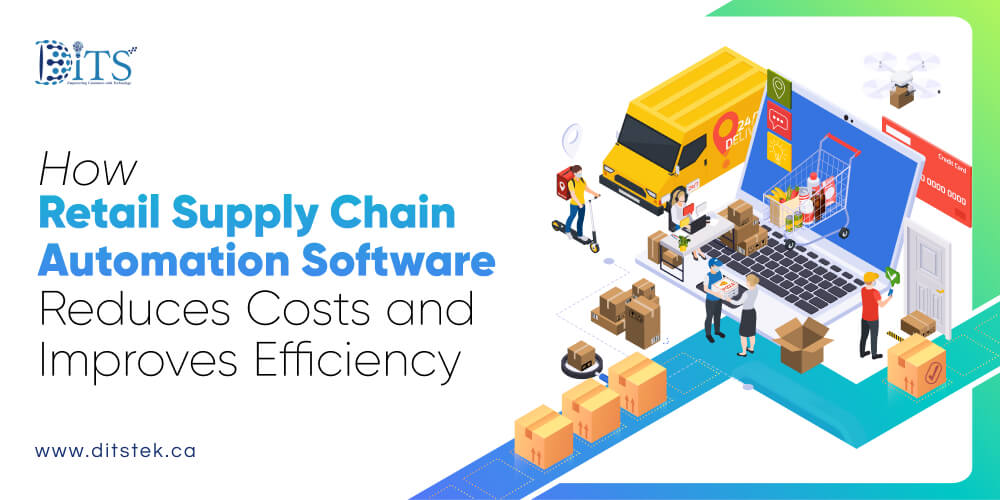How Retail Supply Chain Automation Software Reduces Costs and Improves Efficiency
Ditstek Blogs
Canada's retail industry is growing at a very fast pace, but faces challenges of demand fulfillment. One week everything is in stock, and the next week, it is almost all gone. Retailers have to constantly cope with varying demand and supply shortages and manage inventory to stay profitable. They can hardly put up with the situation when the entire operation is based on multiple systems that do not communicate with each other.
At that point, the retail supply chain automation program comes in. It changes the situation by allowing the company to focus on automating all processes, from product dispatch to storage oversight, helping it save time and money. For Canadian retailers, who are constantly battling unpredictable logistics and tight margins, automation has become the main factor separating good operations from efficient ones.
This blog shares the role and importance of supply chain automation software in improving the efficiency of retail businesses and minimizing costs in Canada.
Current Challenges in Canadian Retail Supply Chains
From an outsider's perspective, running a retail operation in Canada looks easy. Shelves are fully stocked, and smiling customers are checking out without issues, and deliveries flow smoothly. However, in reality, it is a daily act of multitasking. Each link in the supply chain, from suppliers to last-mile delivery, has reasons to be anxious when there are delays. When one link fails, everything slows down.
Rising Costs
Costs are rising across every piece of the retail supply chain. Rising fuel and storage costs, as well as cross-border logistics in Canada, have also increased transportation rates. For retailers, this means less margin and tough choices. Manual operations such as spreadsheets, phone calls, and double data entry also take a lot of team time that could be focused on business growth.
Inventory management
The pressure grows with inventory management. Significant inventory ties up cash flow, and too little inventory leads to frustrated customers. Add supply delays to the equation, and customer confidence will definitely drop.
Labor shortage
With the labor shortages across warehouses and distribution centers, it’s even harder than before. Retailers can’t fill logistics roles, so retailers suffer from longer lead times and unpredictable service levels. In today’s market, if a business takes too long to deliver goods, its customers will just move to whoever can deliver quickly and at affordable prices.
That’s where technology quietly steps in and begins to turn the tide.
Ready to Automate Your Retail Operations?
Discover how customized automation software can reduce manual errors, lower costs, and enhance real-time visibility across your retail network.
What Is Retail Supply Chain Automation Software?
Retail supply chain automation software is a digital command center for retail businesses. It connects the dots between suppliers, warehouses, stores, and consumers. The benefit of such an automation tool is that everything moves in unison, without the need for manual intervention.
Instead of managing tools for inventory, logistics, order management, and potentially other areas all separately, it all comes under one umbrella.
A good retail supply chain software, importantly, not only automates processes but also creates visibility. Once the system knows precisely the movement of each inventory item, be it in transit, on the shelf, or still in inventory awaiting delivery to a consumer, the business gains absolute control over costs and timing.
Modern retail supply chain management software will also use AI forecasting capabilities to predict demand trends with real-time data to avoid either overstocking or running short of an inventory item. It also creates an efficient platform for communication between departments and vendors that turns a slow manual process into a fast, reviewed, data-driven decision-making process.
How Automation Reduces Supply Chain Costs
Reducing costs isn’t simply about cutting expenses; it’s about being more thoughtful and strategic with how to spend or invest the money. When automation takes over routine, repetitive work, those cost savings show up across all aspects of the supply chain. Retail supply chain automation software can reduce waste and increase profitability for retailers without forcing teams to do even more work.
Improved Inventory Management
One of the fastest ways automation reduces costs is by getting inventories right. A retail business with a physical or e-commerce presence should know how much stock it needs to order in real-time, and being able to predict demand accurately and effectively with AI/time management forecasting.
Retail supply chain management software tracks product movement and alerts when stock is running low, well before the inventory shows low, and it can even prevent dead stock from sitting there, wasting money and tying up valuable capital that can be invested elsewhere.
Lower Labor and Administrative Costs
The costs associated with manually updating any kind of inventory or data entry, vendor management, coordination expense, and daily routine are all taking away from what could be valuable selling time. Automation of routine tasks will lower the amount of staff and redirect staff with their time to doing something more strategic, like sales planning, forecasting, and vendor management. The point is not to replace people, but to automate what is considered value-added work.
Reduced Logistics and Shipping Costs
With the automation capabilities retailers have, there are more insights into shipping routes, carrier performance, and delivery schedules. The system will make the most cost-effective carrier selection, optimize routes, and provide real-time status tracking, so there are no late shipments. Fewer late shipments result in fewer penalties and more satisfied customers, as defined by effective logistics software development approaches.
Reduced Losses from Human Error
Every typo, missed order, or miscount can create a big mistake. Automation will prevent that. Data will be collected directly from systems and sensors, reducing human error, which has caused costly return shipping or lost shipments.
These savings don't just improve balance sheets, but they make the whole operation feel lighter and faster.
Want to Cut Retail Operating Costs?
Explore AI-powered automation that helps retailers minimize logistics costs and boost margins without compromising on efficiency.
How Automation Improves Efficiency
Automation isn't simply about reducing expenses; it enables firms to work much faster and more effectively, allowing minor improvements in efficiency to accumulate across different locations and teams, leading to a significant competitive advantage.
Real-Time Visibility and Transparency
Consider having complete transparency of the supply chain: every product, every shipment, every delay, all in one place. That's the transparency that an automated workflow can provide. Retailers can pull together their inventory at every store and warehouse, see issues before they escalate, and rapidly adjust as necessary, eliminating uncertainty in their operations.
Speed of Order Fulfillment
Due to automated picking, sorting, and shipping, orders flow across warehouse and distribution centers faster. When every aspect of an operation is integrated and aligned from sales to inventory to logistics, products reach customers faster, with no bottlenecks and no missed deliveries.
Data-Driven Decision Making
Automation provides data and insights at every step of the operational workflow. Retailers can quickly see which products are sold most quickly, map the line haul routes that save the most on transportation, or identify vendors that cause the most delays in shipping. Having insights into operations can help retail businesses systematically plan for the next quarter, which is a clear demonstration of intelligent business workflow automation.
Seamless Collaboration
When everyone in the business workflow process is on the same platform, from warehouse staff to delivery drivers, miscommunication or missed communication virtually disappears. Automated notifications, shared dashboards, calendared schedules - can easily tie everyone together without.
At DITS, we also use AI-powered systems within our retail software development process to build, test, and fine-tune automation tools that adapt to business over time.
Key Features to Look for in Retail Supply Chain Automation Software
AI-Powered Demand Prediction
A dependable system projects consumer demand from real-time data. It reviews factors such as purchasing trends, seasonality, and regional trends to help order the appropriate level of merchandise at the right time.
Automated Warehouse Management
From barcode scanning to robotic picking, automation can make a warehouse run like clockwork. Each item is observed, packed, and sent to the customer, minimizing human error and delays.
Order and Shipment Tracking
Retailers need to know where their shipments are at all times. Knowing where the order progress and any delivery delays happen builds trust and transparency.
Integration with ERP or POS Systems
The best retail supply chain software can seamlessly integrate into daily use. Once connected, the sales, finance, and logistics datasets can function in the same ecosystem.
Real-time Analytics Dashboard
Dashboards turn perplexing data into visual graphics. Retail managers can review what is working, lagging, and where costs are surging around real-time analytics, all in one location.
Struggling With Supply Chain Inefficiencies?
Unlock seamless automation that simplifies warehouse management, inventory tracking, and order fulfillment with a tailored retail solution.
Why Choose DITS for Supply Chain Automation Software
Every retail company is distinct, with its own unique combination of products, partners, and processes. Off-the-shelf systems never seem to accommodate that complexity. At DITS, we begin by learning business processes and then build technology that fits how they operate.
Our team offers custom software development services that streamline the daily operation of your business, connect disparate data from one department/functional area to another, and improve visibility of data and actions. Whether you're managing inventory across provinces, tracking movement, or coordinating multiple suppliers, our solutions are designed to keep things moving without pause.
Additionally, we embed AI at every stage of the development cycle, from the design stages through testing and finally optimization, so every system we provide is efficient, secure, and manageable. This is not about adding another tool, but rather providing your teams smarter ways to scale and operate with confidence.
Conclusion
In the era of retail, success is dependent on speed, accuracy, and flexibility. As customers are putting harder demands on retailers and competition around Canada is increasing, automation has silently become the basis of smarter operations. Retail businesses can use automation software for supply chain systems, translating complicated supply chains into a harmonized execution process that reduces time, cuts waste, and promotes faith in their customers.
Automated execution allows retailers to have data-driven solutions, lessen manual errors, and maintain operations when disruption occurs. Enterprises with early automated adoption not only lower costs, but also have options to respond to market fluctuations.
For retail enterprises seeking to strengthen their market position, investment in automation is no longer optional. It is now the next rational step in efficiency and growth.
FAQs
Q1. How does retail supply chain automation software help Canadian retailers save money?
Retailers can save on labor costs, eliminate costly human errors, and improve order accuracy by automating tasks instead of performing them manually. The system also takes a proactive approach in deciding the inventory and the movement of goods, leading to decreased costs in storing and transportation while making the entire process faster.
Q2. What is the average cost of implementing supply chain automation software?
The price varies based on the retail operation's size, integration, and system complexity. Generally, the average amount for a custom-built solution is between CAD 30,000 and CAD 150,000 for mid-sized Canadian retailers.
Q3. Can small retail businesses benefit from automation?
Definitely, small retailers do not lose out on benefits such as reduced errors, improved visibility, and better control over stock and deliveries. Just as the company grows, so does the automation. You can start with a small scale of operations and gradually move on as the business grows.
Q4. How long does it take to implement a retail supply chain software solution?
Implementation generally takes 3 to 6 months, depending on the amount of data transferred, the systems are integrated, and the level of customization. The implementation timeline will be shorter if the company is already partially cloud-based or digitized.
Q5. Why should I choose a custom automation solution instead of ready-made software?
Custom solutions fit your business's processes, data structure, and goals perfectly. They will not restrict you in comparison to off-the-shelf systems that can be scaled and integrated but not highly personalized. This results in an efficient process that is sustained over time and gives better ROI.

Dinesh Thakur
21+ years of IT software development experience in different domains like Business Automation, Healthcare, Retail, Workflow automation, Transportation and logistics, Compliance, Risk Mitigation, POS, etc. Hands-on experience in dealing with overseas clients and providing them with an apt solution to their business needs.
Recent Posts
Get in touch











